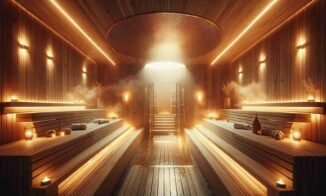After a tough workout, long shift, or heavy training day, muscle soreness can feel unavoidable. The stiffness, tension, and slow recovery that follow are familiar to anyone who’s active. One method that continues to gain popularity for easing soreness is sauna therapy. The heat, the calm, the time to unwind — it feels good. But does it actually help?
Let’s break down how saunas support muscle recovery, what’s happening in your body during heat exposure, the difference between steam and infrared saunas, and when cold therapy has a place in your routine.
How Sauna Heat Supports Muscle Recovery
When you sit in a sauna, your body responds to heat by increasing circulation. Blood vessels widen, allowing more oxygen-rich blood to reach your muscles. That oxygen is key for repair — and increased blood flow also helps remove waste products left behind after exercise.
This process can reduce the intensity and duration of muscle soreness. Research published in Annals of Medicine and similar clinical reviews has linked regular sauna use to improved recovery, reduced stiffness, and overall better exercise tolerance.
Sauna heat supports recovery by:
Increasing Circulation
Heat dilates your blood vessels, sending more nutrients to damaged muscle fibers.
Helping Clear Metabolic By-Products
Lactic acid and other exercise by-products are flushed more efficiently when circulation improves.
Releasing Muscle Tension
Heat encourages your muscles to relax, easing tightness in the neck, lower back, shoulders, or legs.
For a deeper look at the overall wellness benefits of regular sauna use, see:
7 Proven Health Benefits of Regular Sauna Use
Steam vs. Infrared: Which Sauna Is Better for Sore Muscles?
Both steam and infrared saunas offer recovery support, but they work differently.
Steam Saunas
A traditional sauna uses heated air and steam to warm your body.
This high-humidity environment helps relax muscle fibers and can soothe joint discomfort. Many people also find steam helpful for respiratory comfort during colds or allergy seasons.
Infrared Saunas
Infrared saunas heat the body directly rather than warming the air.
This allows for lower room temperatures while still encouraging sweating, circulation, and muscle relaxation. Infrared heat penetrates slightly deeper into tissue, which some people find more effective for soreness and recovery.
If you’re choosing a sauna primarily for post-workout relief, either can work — it’s mostly down to comfort and personal preference.
Browse both types here:
https://prolinedirect.co.uk/product-category/home/sauna/
When to Use Cold Therapy Instead of Heat
Heat isn’t always the answer.
If you’ve just completed an intensive training session or you’re dealing with acute swelling, cold therapy may be more effective in the short term. Cold reduces inflammation by constricting blood vessels and numbing the area. Many athletes alternate hot and cold therapy — the contrast can support circulation while controlling inflammation.
A good rule of thumb:
-
Heat = muscle relaxation, circulation, general soreness
-
Cold = swelling, inflammation, post-impact recovery
A balanced approach usually delivers the best results.
Safety Considerations When Using a Sauna for Recovery
Sauna therapy is generally safe, but a few precautions matter — especially when your system is under stress.
-
Stay hydrated. Sweating removes fluids quickly.
-
Avoid the sauna if you are feverish or feeling faint.
-
Leave if you feel dizzy or overheated.
For guidance on how heat affects the body and when to take caution, see:
NHS – Heat exhaustion and heatstroke
HSE – Thermal comfort in heat environments
These resources explain signs to watch for and how the body responds to elevated temperatures.
Conclusion
Saunas can be a powerful recovery tool. The heat increases circulation, eases tension, and supports your body as it repairs muscle tissue. Whether you prefer the enveloping warmth of steam or the gentler, direct heat of infrared, both methods can help reduce soreness and improve mobility after exercise.
Pair your sauna sessions with good hydration, rest, and — when needed — thoughtful use of cold therapy. Listen to your body and adjust session length and temperature as needed.
If you’re looking to add a sauna to your recovery routine, explore the full selection here:
https://prolinedirect.co.uk/product-category/home/sauna/







